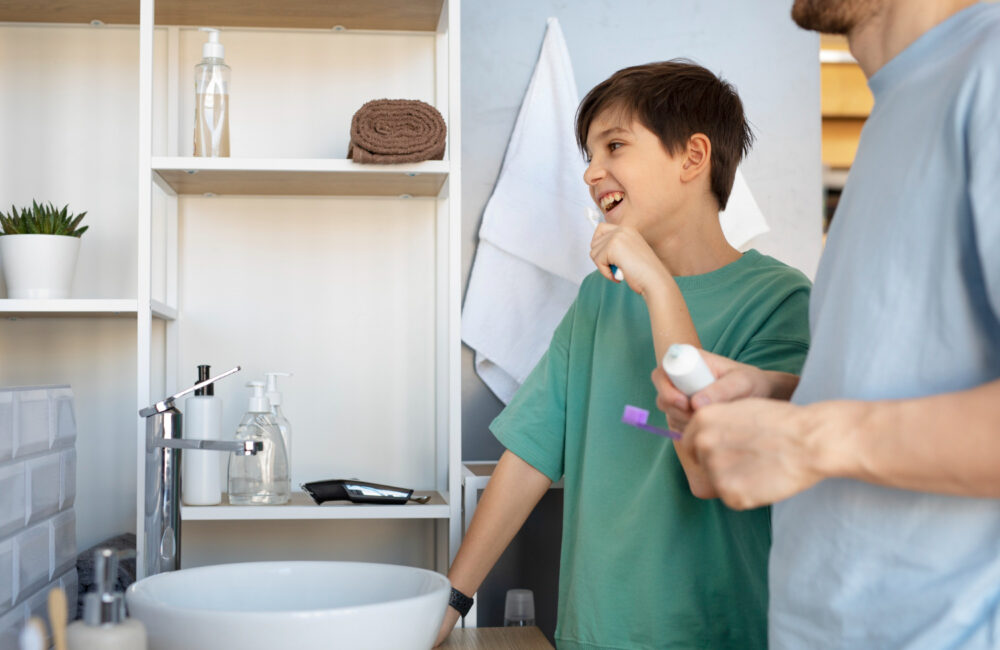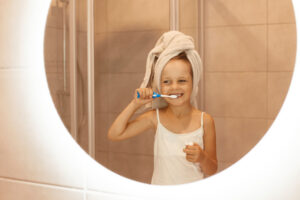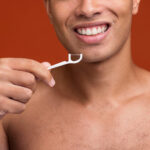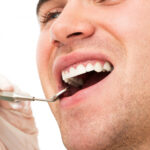
As a parent, you have to pick your battles with your child, even when it comes to hygiene. If your kid hates having their hair brushed, you can negotiate a shorter cut that requires less maintenance. If they want to keep wearing their favorite pair of pants long after both knees are ripped, you can chalk it up to their unique style and let it go. One thing you can’t compromise on? Brushing teeth. And not just because clean, healthy teeth might help you avoid expensive orthodontic care when your kids are older (although that, too!), but also because good oral hygiene is important to overall health. Some experts even think the bacteria that occurs with gum disease may be able to move into the bloodstream, potentially having a negative effect on heart health.
Between the ages of three and six, kids can take over this task with adult assistance, and, by age eight, they should be brushing their teeth all on their own. If your child still fights you when it’s time to brush their teeth or refuses to claim any responsibility for this hygiene habit, it’s time to help them get their mouth into a sparkling, smiling shape. Wondering how to get them there? It’s a step-by-step process. Here’s how to start.
Talk to Them
How many times have you told your child to brush their teeth only to be answered with a whine or complaint? Brushing your teeth seems like a total waste of time to most kids; it’s boring, their teeth don’t look dirty, and who cares what happens to baby teeth, anyway?!
Well, your kid should care…baby teeth are important! According to the American Dental Association, they hold space for the adult teeth that will come in later; losing baby teeth too early to tooth decay can cause overcrowding and other problems.2 But your kid doesn’t know any of that, so you should talk to them about the importance of brushing their teeth twice a day.
Teaching your kids about good oral hygiene—and putting them in charge of it—often works better than the authoritarian “Because I said so!” approach. Here are some basic talking points and strategies you can use whenever you get pushback from your child about taking care of their teeth.
Basic talking points and strategies
- Brush your teeth alongside your child in the morning and the evening. Little kids like to copy adult behaviors.
- Cater to their preferences. If your child only wants bubble gum-flavored toothpaste, don’t insist on mint. If they want to try an electric toothbrush (oh, the novelty!), that’s fine. Whatever gets them brushing.
- Do a cavity science experiment. Many kids learn best when they have a visual example, so it may help to show your child what happens to their teeth when they eat, and then when they don’t brush.
- Offer lots of choices. Instead of mandating when exactly your child needs to brush their teeth, ask if they want to brush them before or after they get dressed in the morning. This makes them feel in control without letting them off the hook.
- Play pretend. Little kids will love brushing the teeth of their favorite dolls and stuffed animals, so give them a dollar store toothbrush and let them role-play dentist. See if they can explain to their toys why brushing is so important; teaching often reinforces learning.
- Remind your child that we wash our hands several times a day to get rid of germs so we don’t get sick, and when we brush our teeth we’re doing the same thing.
- Take turns. Allow your child to brush their own teeth first, and then tell them it’s your turn. Kids under six don’t have the motor skills to be able to brush effectively, so they need an adult to brush for them. But giving them the chance to do it first helps them learn and practice.
Break the Task Down Into Steps

- Take out your toothbrush and your toothpaste.
- Run the brush part of your toothbrush under cold water while you count to three.
- Turn off the water and put a pea-sized amount of toothpaste on your brush.
- Start a two-minute timer. You can buy a kid-friendly timer or even an app, like the Disney Magic Timer, designed to help kids brush their teeth if that motivates your child. But a basic hourglass timer, kitchen timer, or iPhone timer works just fine, too. Or try Chompers, a podcast for 3- to 7-year-olds to listen to while they brush (it offers two daily two-minute episodes).
- Brush your teeth until the two minutes are up, paying attention to all four parts of your mouth (and don’t forget your tongue!).
It might sound silly to you since you could probably brush your teeth in your sleep, but kids get overwhelmed quickly by multi-step tasks. They have to take out their toothbrush and put toothpaste on it and then they have to brush their teeth?! Cue meltdown.
Thankfully, this is a problem easily solved. Split all these small, simple tasks up for your child so they can check them off one by one
For example:
- Teach your child that their mouth can be divided into four parts—top left, top right, bottom left, and bottom right—before trusting them to brush independently. Lots of kids unintentionally focus on one small area, neglecting everything else.
- When the timer runs out, spit, rinse, and put your toothbrush away so the head is upright in its holder or cup.
- Some kids will be able to memorize these steps with a little practice, but others will need a visual reminder. That’s okay! Write or print out this list of instructions, or create an ordered set of pictures so they can follow along with the steps. Laminate it and leave it in the bathroom so your child can refer to it as they learn to brush independently.
Foster an Independent Routine
Kids are often forgetful, but they’re also creatures of habit (just like grownups!). Connect your child’s oral hygiene to everyday activities they engage in without conscious thought: when they dress or undress, as they enter or exit the tub or shower, before breakfast, or after having dessert. This is the easiest way to help your child make oral hygiene a part of their routine.
In the beginning, you’ll have to do more prompting—and you may have to remind yourself to remind them. After a few weeks, though, you can step back and see how well they are remembering on their own.
Once you feel your child has successfully taken on the responsibility by themselves, you still can’t go fully hands-off. You should plan to check in with your child on a regular basis to ask them if they’re remembering to brush twice a day and if they have noticed any changes to their teeth or gums, like pain or sensitivity.
Depending on the child, you may need to visually inspect their mouth to make sure they’re brushing thoroughly enough (or even check their breath to make sure it isn’t too stinky!). Even if your child is keeping up with their brushing routine, you still hold the responsibility for their oral health at this point. Thus, you need to ensure that they are performing it correctly.
Related / How To Prepare Your Child For Their First Dental Appointment













